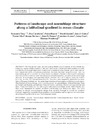Please use this identifier to cite or link to this item:
https://accedacris.ulpgc.es/jspui/handle/10553/49585
| Title: | Patterns of landscape and assemblage structure along a latitudinal gradient in ocean climate | Authors: | Tuya, Fernando Cacabelos, Eva Duarte, Pedro Jacinto, David Castro, Joao J. Silva, Teresa Bertocci, Iacopo Franco, Joao N. Arenas, Francisco Coca, Josep Wernberg, Thomas |
UNESCO Clasification: | 250501 Biogeografía 251005 Zoología marina 241705 Biología marina |
Keywords: | Latitude Macroecology Habitat structure Assemblage structure Kelps, et al |
Issue Date: | 2012 | Journal: | Marine Ecology - Progress Series | Abstract: | The Portuguese coast has overlapping distributions of species of both boreal and Lusitanian origins; a large number of cold- and warm-water species have their southern or northern distributional range edges here. A latitudinal gradient in ocean climate, particularly sea surface temperature (SST) and primary production, has been described along this coast. Here, we took advantage of this gradient in ocean climate to explore affinities in the biogenic landscape structure of subtidal shallow reefs (the abundance of habitat patches), as well as in the assemblage structure of macroalgae and associated fishes, between each of 3 regions: Viana do Castelo (41.5°N), Peniche (39.2°N) and Sines (37.8°N). Five reefs were sampled to determine the abundance of biogenic habitats and the assemblage structure of macroalgae and fishes in each region. The structure of the landscape, and of macroalgal and fish assemblages, differed between Viana do Castelo and Peniche and between Viana do Castelo and Sines, but not between Peniche and Sines. Viana do Castelo was the only region with conspicuous kelp forests, while Peniche and Sines were dominated by patches of foliose turf-forming and filamentous algae. Our study revealed an abrupt macroecological change from northern Portugal to central and southern Portugal, suggesting a possible biogeographical reconfiguration and recognition of a wider transitional area from the Atlantic into Mediterranean waters. | URI: | https://accedacris.ulpgc.es/handle/10553/49585 | ISSN: | 0171-8630 | DOI: | 10.3354/meps09941 | Source: | Marine Ecology Progress Series [ISSN 0171-8630], v. 466, p. 9-19 |
| Appears in Collections: | Artículos |
SCOPUSTM
Citations
87
checked on Jun 8, 2025
WEB OF SCIENCETM
Citations
86
checked on Jun 8, 2025
Page view(s)
137
checked on Nov 30, 2024
Download(s)
125
checked on Nov 30, 2024
Google ScholarTM
Check
Altmetric
Share
Export metadata
Items in accedaCRIS are protected by copyright, with all rights reserved, unless otherwise indicated.
